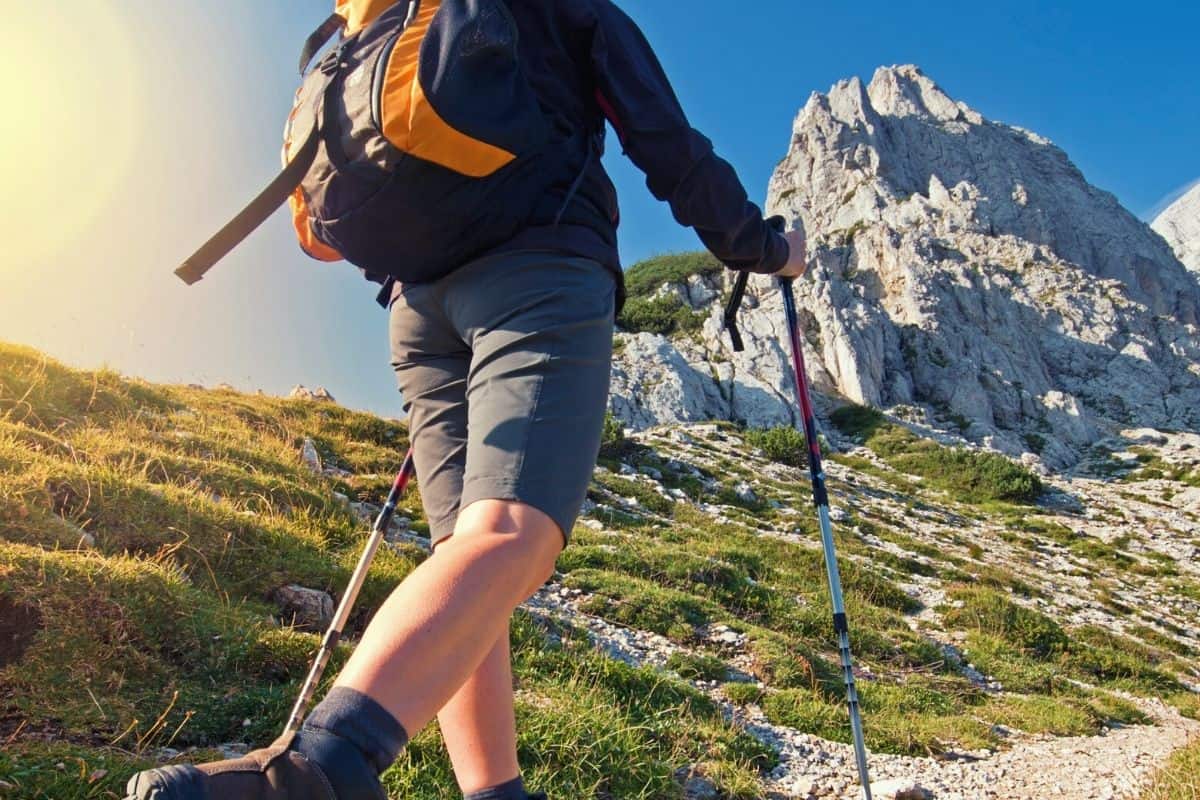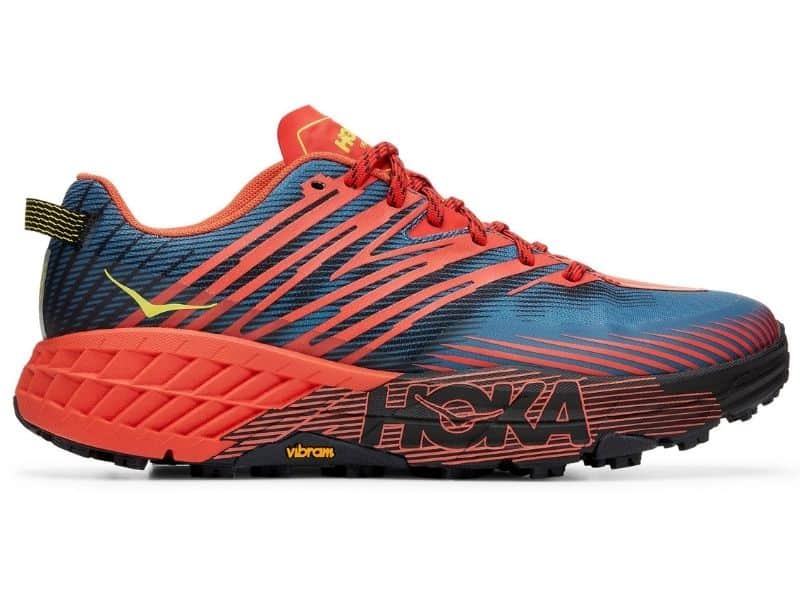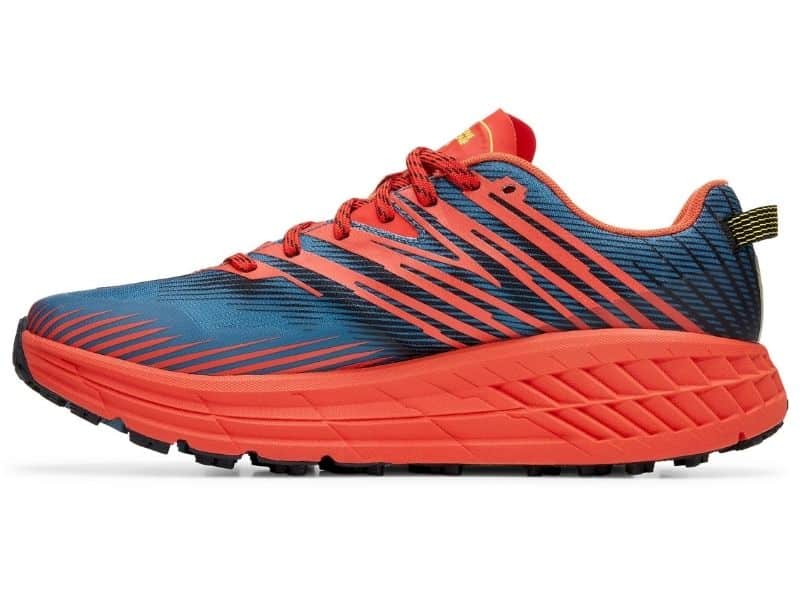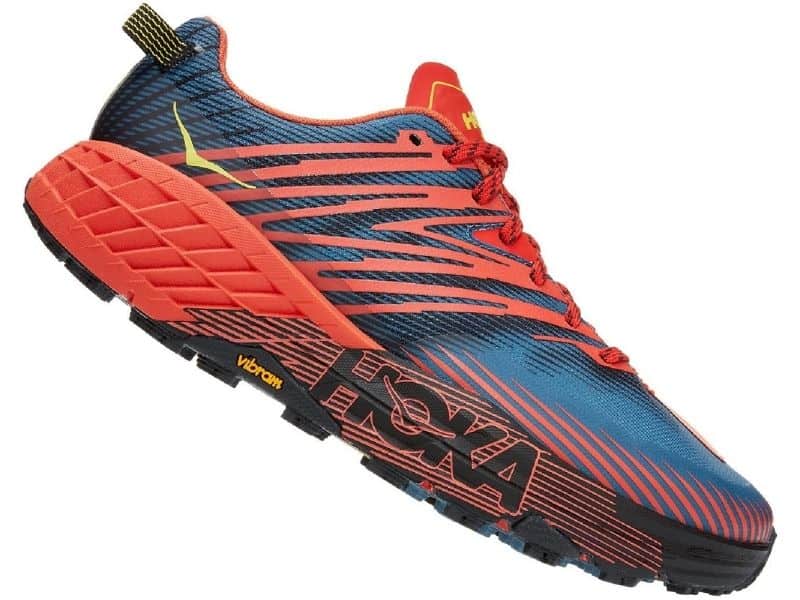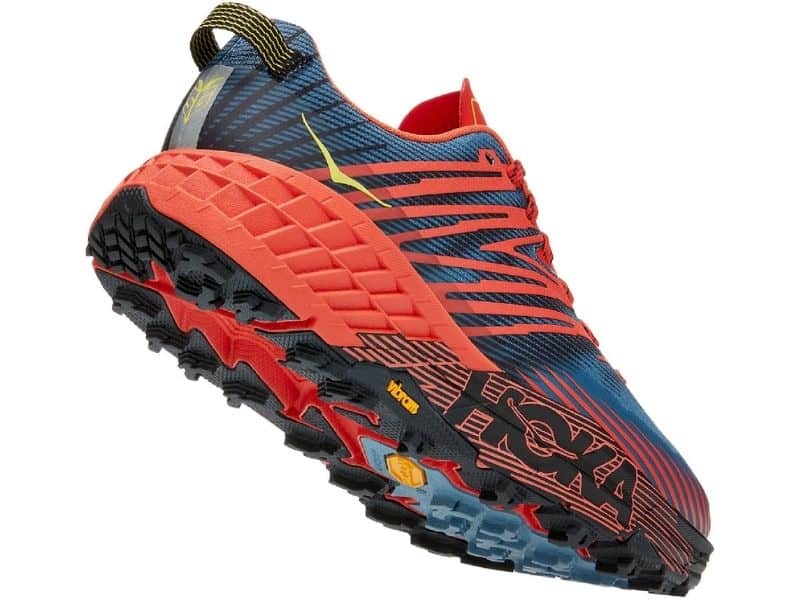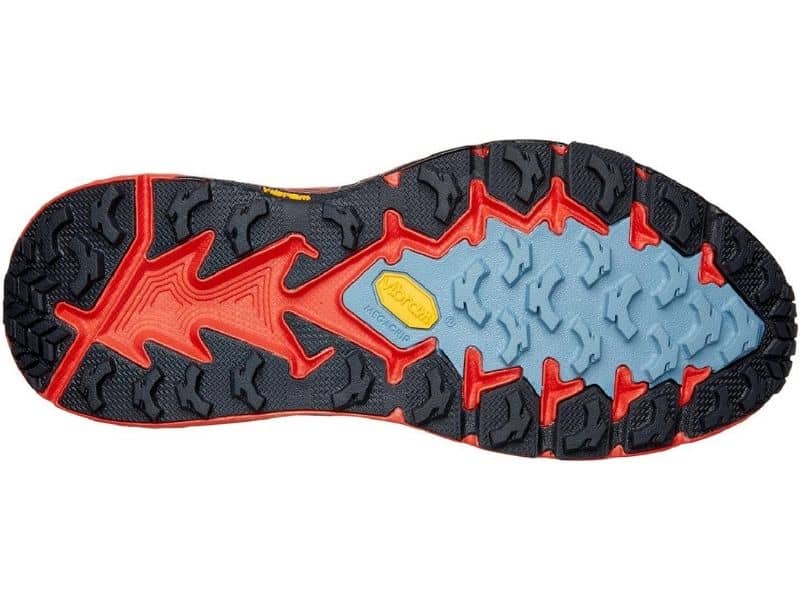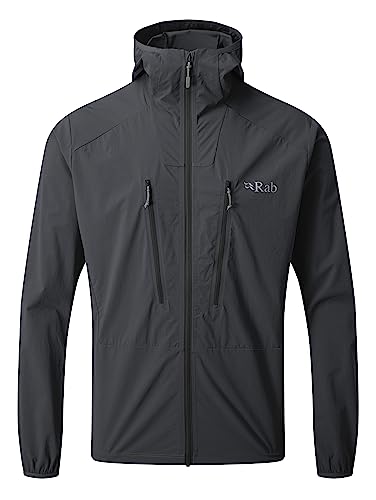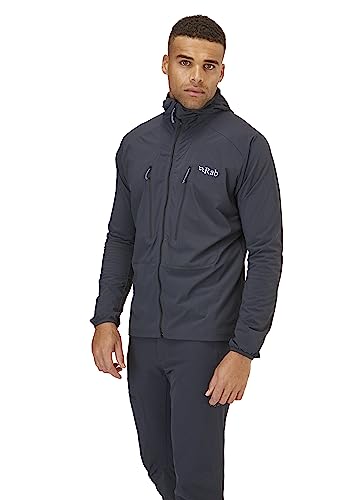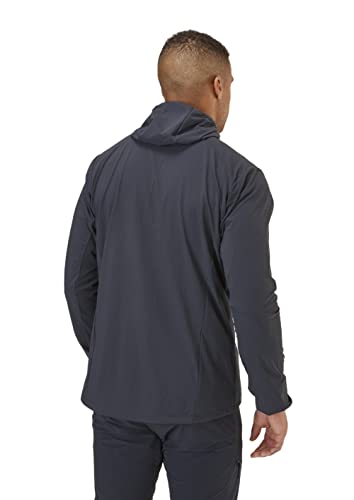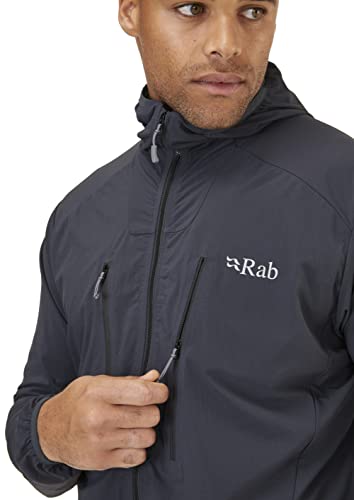The success or failure of a hiking trip often hinges on the gear choices we make, especially our clothing. Dress too warmly, and you risk heat exhaustion. Underestimate the cold, and you may end up with hypothermia. Neglect rain attire, and your hike can become quite miserable!
These days, we have countless clothing options available. So many, in fact, that beginners might be tempted to grab the first decent-looking garments to avoid feeling overwhelmed. To help you resist this temptation, we’ve compiled this guide to assist you in choosing hiking apparel for all seasons and conditions.
In this article, we’ll guide you through the essential hiking gear for your upper body, lower body, footwear, and useful extras for comfort and warmth. We’ve also included a convenient cheat sheet outlining the ideal attire for various weather conditions, followed by an evaluation of different hiking fabric options and the key features to consider in choosing outdoor activewear.
Finally, learn the tricks of the trade with our top tips for dressing for hiking success.
Do
Don’t
Table of Contents
Save for later!!! ⤵️
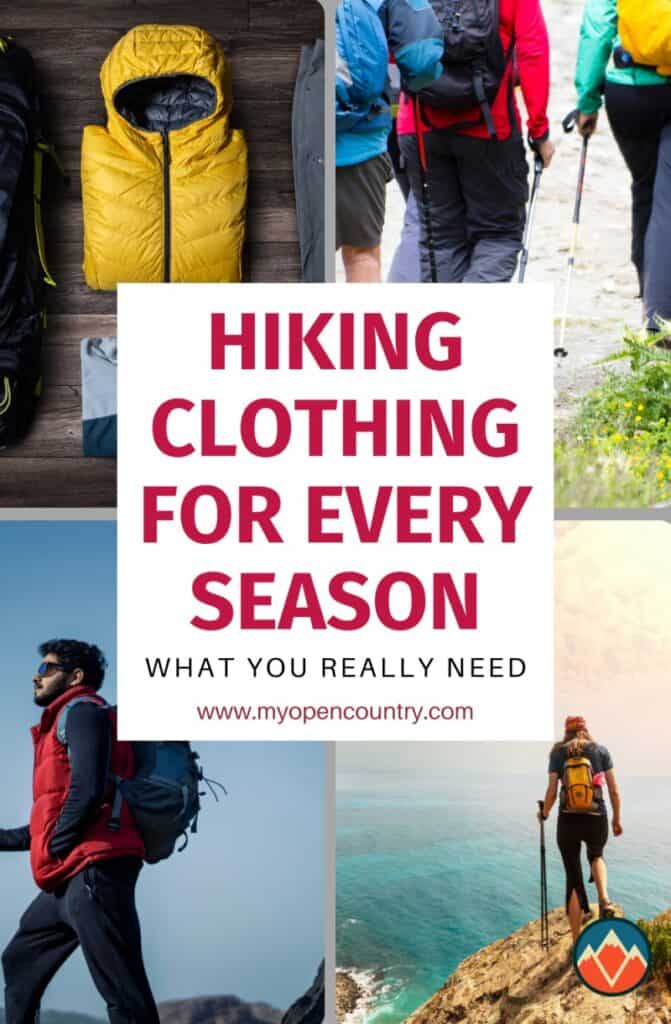
What to Wear On A Hike?
The following overview is designed to offer a comprehensive all-season hiking clothing guide, ensuring you always know what to wear for comfort and safety. The layering system, on which this guide is based, allows you to adjust layers according to the temperature you’re exposed to and is subdivided into the following list.
- Hiking Tops
- Hiking Bottoms
- Hiking Footwear
- Hiking Extras
1. Hiking Tops
Starting up top, we recommend a breathable, high-wicking baselayer (such as the Smartwool Merino 150 t-shirt), adjusting the weight or thickness based on the hiking temperature. In cooler conditions, you can add a thicker fleece, down jacket, or softshell midlayer. In bad weather, layer these with a wind and rain shell.
2. Hiking Bottoms
What you wear on your bottom half is very much temperature and preference-dependent. In high temperatures, you can either opt for lightweight hiking pants like the Outdoor Research Ferrosi, or a pair of hiking shorts or skorts. Just be sure to check you won’t be wading through thorny or nettle-riddled brush before plumping for the latter.
The ideal solution may be to get your hands on a pair of convertible pants with zip-off bottoms and ankle zips that allow you to remove the lower sections without taking off your boots. Our favorites are the Columbia Silver Ridge zip-off pants.
Hiking leggings and yoga pants are also becoming an increasingly common sight on the trails, mainly because they offer great mobility, breathability, and comfort.
In cold weather, a good idea is to start with a pair of softshell pants with some degree of wind resistance. Alternatively, wear hiking leggings or baselayer pants below your standard hiking pants.
If conditions are wet or particularly blustery, throwing a pair of lightweight waterproof rain pants directly on top of either your baselayer or standard hiking pants will keep your pins toasty and dry.
3. Hiking Footwear
Your choice of footwear depends largely on your hiking destination and the anticipated conditions. Opt for hiking boots in muddy, boggy, or snow-covered terrain. For well-maintained, dry trails, consider a good pair of hiking shoes or trail running shoes. Trail runners can offer a cost-effective, nimble, and comfortable alternative. We love the Hoka One One Speedgoat 4 for its cushioning, stability, and durability.
4. Hiking Extras
A few additional hiking items to consider wearing include wide-brimmed hats, sunglasses, gloves, liner gloves, gaiters, and buffs. These are expanded upon on the list below as well as what to look for in the particular hiking underwear and socks you choose to wear.
Wide-brimmed hat — Spending hours on the trail under even a moderate sun can make you vulnerable to heatstroke, sunstroke, and of course, burning. As such, choose the best hiking hat you can find – this 50-100g addition is well worth its inclusion in any backpack on sunny days.
Sunglasses — An optional extra that becomes all but imperative when in snow-covered terrain, where snow blindness and headaches become a real possibility for unprotected peepers. For sunglasses that give your eyes complete protection, we’d recommend a pair featuring protective side shields, such as the Julbo Vermont, which also happen to look, quite frankly, awesome.
Gloves — Conditions will dictate just how serious a pair of gloves you will need, but a general rule is that if it’s cold enough to have one pair, it’s cold enough to have two. Insulated and waterproof gloves are recommended for cold-weather hiking.
A second liner glove can serve as an emergency backup and prove very useful for limiting exposure when performing more delicate tasks such as taking pictures, tying laces, putting up your tent, or taking readings from a map and compass.
Gaiters — A very handy addition to help keep your feet dry when hiking in boggy, wet terrain. They also help to keep small stones, twigs, snow, and bugs out of your boots.
Buffs — This very lightweight, versatile little piece of gear is a worthy addition to keep your head warm. It can be used as a hat, neck protection or warmer, and a substitute bandana to provide sun protection in warm weather.
Underwear — Perhaps more than any other body part, your intimates need to breathe and shed excess moisture. Merino wool and quick-drying “tech” undies such as the Arc’teryx Phase SL are high-wicking and far more breathable than standard cotton items.
Hiking socks — Again, avoiding cotton is essential. Breathable merino wool socks such as Darn Tough’s Micro Crew Hiker Cushion Socks or Danish Endurance Crew are the best way to avoid soggy soles, blisters, and, of course, stinky feet.
Hiking Clothes: Cheat Sheet
For a concise guide on what clothes to wear while hiking, refer to our quick cheat sheet below. The four scenarios provide baseline recommendations for different seasons. As conditions can vary significantly, we recommend reading through the entire article so you can develop a clothing system suitable for you and your specific environment.
The following recommendations are based on our own experience and personal preferences so we advise you to take them as a general guide on what to wear when hiking, rather than hard and fast rules.
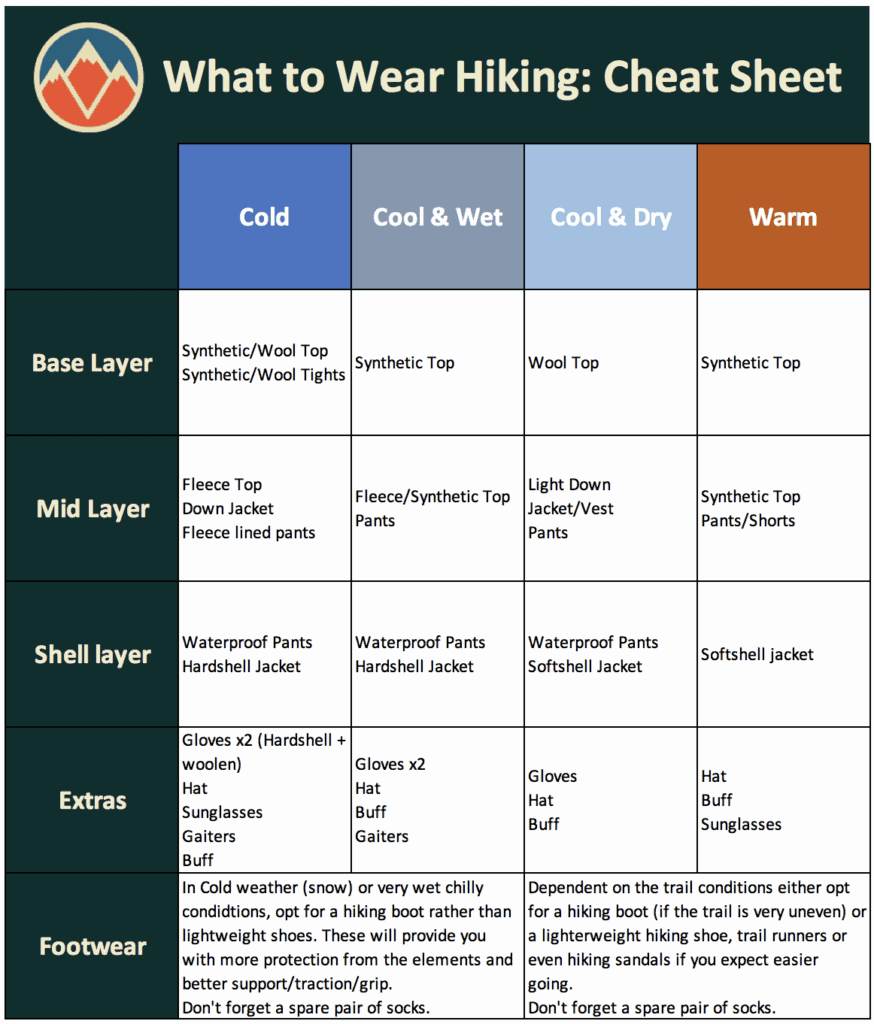
Which Fabric is Best for Hiking Clothing?
The most popular hiking fabrics are listed below along with the benefits and drawbacks of each.
- Fleece
- Wool
- Polyester/Nylon
- Down
- Silk
- Cotton
1. Fleece
Fleece is a low-cost insulator that dries quickly, feels soft against the skin, and offers an excellent warmth-to-weight ratio, making it a good midlayer option. The only drawback is its lack of wind resistance.
2. Wool
Wool has experienced a revival in recent years, thanks to brands such as Icebreaker and Smartwool. Modern wool-made hiking garments are far more high-performing than those of the past. They provide a slightly pricey but otherwise cozy, soft, stink-free, breathable, and high-wicking option that insulates even when wet. They work particularly well in base layers, as explained in the video below.
The only downside to wool is that it offers little wind resistance, is often pricey, and, particularly in meatier layers, can take a long time to dry.
3. Polyester/Nylon
Polyester and nylon are found in everything from shoes, gaiters, baselayers, long-sleeved shirts, hiking jackets, and hats. These synthetic fabrics aren’t always as comfortable or odor-resistant as, for example, merino wool or bamboo products. However, they are usually more budget-friendly and dry much quicker.
Most shell layers also use polyester or nylon (or both) with a DWR (Durable Water Repellent) finish to provide protection from the elements.
They come in many forms and with varying specifications, with most big brands offering their own trademarked versions such as Air Tech (Mountain Hardwear), Capilene (Patagonia), and Polartec (various).
4. Down
Down is an ideal insulator in dry, cold conditions. Down jackets come in various ‘fill powers’ (usually between 400 and 900), which refers to the amount of insulation provided by the garment’s feathered contents. In essence, the higher the fill power, the more body heat a down product can trap.
If heading into high alpine environments, down is a great choice. In more humid conditions, however, synthetic fabrics are a better option – when wet, down loses most of its insulating capacity and can take a small age to dry out.
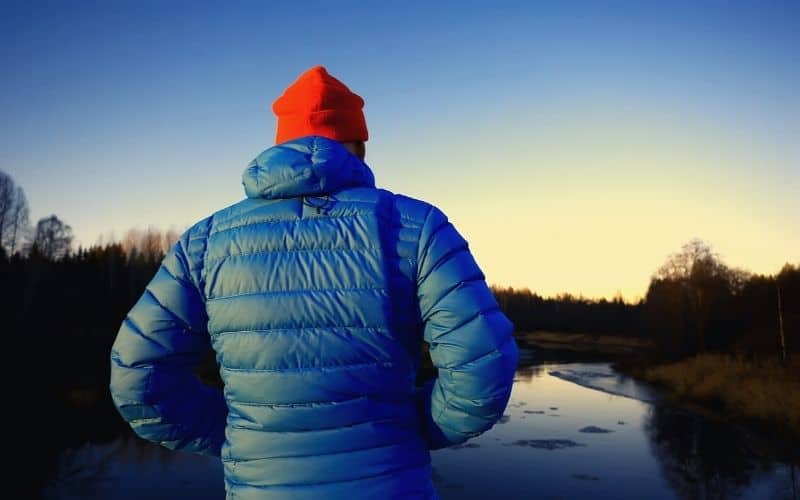
5. Silk
Though fairly rare these days, silk was once the fabric of choice for the world’s mountaineering elite, mainly due to its ability to provide superb insulation at an incredibly low weight. The downside was that it costs a small fortune, wicks as well as your average sponge (i.e. terribly), and tears easily.
6. Cotton
Cotton clothing is the junk food of outdoor attire. While it’s inexpensive, readily available, and initially comfortable, it has the potential to be downright deadly. Known for absorbing sweat, lacking wicking properties, and having poor breathability, cotton not only can cause discomfort and chafing, but it can even lead to hypothermia or, in extreme cases, death. Avoid it at all costs.
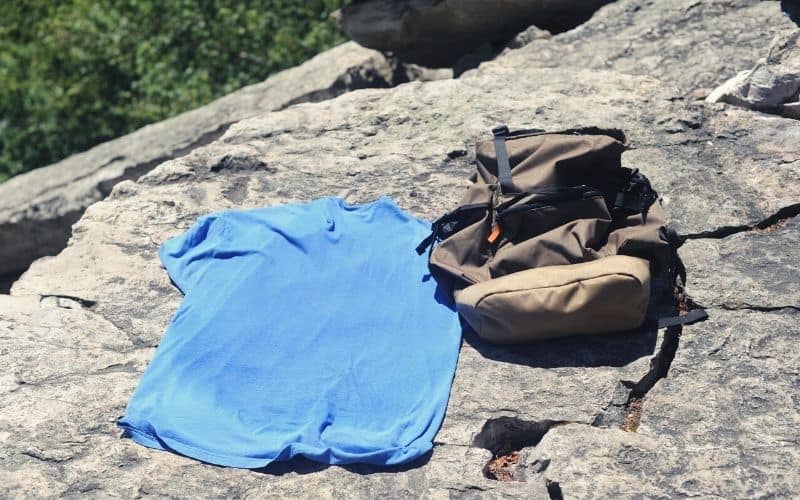
What Qualities Do The Best Hiking Clothes Have?
Whatever fabric you choose for your hiking attire, the label or product description will likely boast one or more desirable qualities or functions. The most important of these are outlined in the list below.
- Moisture-Wicking
- Insulation
- Waterproof
- Breathable
- Waterproof-Breathable
- Windproof
- Stretch and Mobility
- Sun Protection
1. Moisture-Wicking
“Moisture-wicking” refers to a fabric’s ability to transport moisture (i.e. sweat) from inside to out, effectively moving it away from your skin or internal layers. This prevents you from feeling excessively damp while working up a sweat, and also significantly reduces the risk of hypothermia, chills, and other potential issues when your sweat cools down—a real concern with fabrics that lack effective moisture-wicking capabilities.
2. Insulation
To insulate yourself against the cold, you’ll need to create a buffer between yourself and the surrounding air. This is the role of the insulating layer, typically embodied by an insulated jacket, which effectively captures the warmth generated by your body temperature. A reliable insulating layer can take many forms; wool, fleece, down, or synthetic down substitutes are the most common options, all of which are good at trapping body heat.
Generally speaking, the thicker the clothing layer, the more insulation it will provide. However, be wary of sacrificing breathability if opting for especially heavy midlayers, particularly those using synthetic materials inside a wind or water-resistant shell fabric.
3. Waterproof
The most important thing to note when buying an outer layer, whether pants or jacket, is nearly all garments fall into either the “waterproof” or “water-resistant” category. The distinction is an important one. While the former is made to keep you completely dry, the latter is designed to repel only moderate precipitation, such as in a light drizzle or a brief shower.
A second point of note is that any entirely waterproof garment will also be windproof. This is handy given that wind can be as effective as cold ambient air and saturated clothes at spiriting away your body heat.
Finally, thanks to Hydrostatic Head testing (a.k.a. ‘pressure head’ or ‘water column’ testing), there are now degrees of waterproofing. Given in a measurement of mm, these ratings refer to the amount of liquid a garment’s material can withstand before allowing droplets to seep through.
At the lower end of the scale, a rain jacket with a 1,500 mm rating will keep you dry if caught in a spot of drizzle. A waterproof jacket or pants boasting a 20,000 mm rating, on the other hand, will do the job even when things take a turn for the biblical and your neighbors start building arks.
4. Breathable
“Breathability” refers to a garment’s ability to allow moisture to travel from the inside to the outside, preventing it from being trapped within any specific layer. This quality is particularly crucial for the performance of your base layer. When moisture can pass through the base layer fabric to the exterior, it no longer remains in contact with the skin, and the fabric also dries more rapidly.
That said, if any garment in your layering system doesn’t breathe well, the rest of them are unable to fulfill their function. This can result in an accumulation of moisture trapped inside your layers and, at worst, can create the perfect environment for a significant loss of body heat – and potentially hypothermia – when you stop moving or temperatures drop.
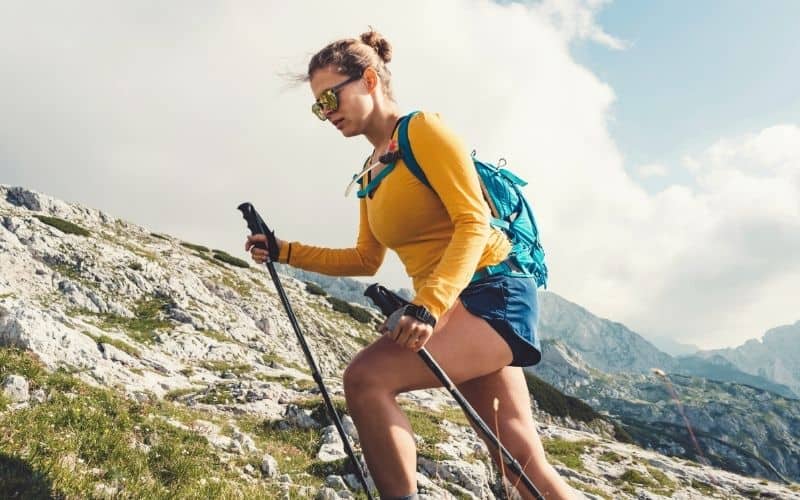
5. Waterproof-Breathable
A fully waterproof and breathable rain jacket or pants have long been regarded as the Holy Grail of outdoor clothing. Nowadays, the R&D departments of major brands have nearly fulfilled this quest, but it does come at a significant cost to the customer.
Yep, you can get your hands on a jacket or rain pants that will fend off small tempests and monsoonal deluges, all while letting your body and inner layers breathe, but only in exchange for a tear-inducing portion of your savings.
Affordable options usually feature a compromise on either of these two above features, with the most breathable fabrics being less waterproof and the most waterproof being less breathable.
At the economy end of the scale, there are coated non-breathable shells. These may look like they will do the job but a short way down the trail are likely to make you feel like you’re wearing a spacesuit in a steam room due to their lack of breathability.
A happy medium, however, can be found in many mid-range Gore-Tex jackets. Our favorite is the Marmot Minimalist, which breathes well, boasts a healthy 28,000mm waterproof rating, and also won’t break the bank.
6. Windproof
As mentioned above, a hardshell waterproof outer layer will also tick the windproofing box and can be worn on top of even the lightest base layers to ward off windchill. If conditions are dry but cool enough to demand some degree of insulation, midlayer tops such as the Rab Borealis are a good choice. This top has a tight enough weave to resist the worst of the wind’s effects while offering more insulation than thinner outer shells.
7. Stretch and Mobility
The stretch and mobility of hiking clothes is crucial. Clothing should be loose-fitting enough to ensure you can move freely, avoid chafing, and allow for airflow between layers. Look for features like a stretch waistband, gusseted crotch, softshell inserts on hardshells, or fabric containing some percentage of lycra, elastane, or similarly stretchy materials. These features significantly enhance comfort and allow unrestricted movement.
8. Sun Protection
Unless you only hike at night, opt for a fabric with an ultraviolet protection factor (UPF) rating to shield you from the sun. UPF ratings range from 15 to 50+, with higher numbers providing better protection. A UPF rating of 20 means the fabric allows 1/20th of available UV radiation to pass through, while a rating of 50 allows 1/50th, and so on.
The perils of skin cancer need no introduction here, but the added risks to hikers of this and other sun-induced illnesses are well worth noting. Hiking at altitude, on snow, and/or spending far more hours exposed to the sun’s UV rays make hikers a particularly at-risk demographic in need of extra protection from the big yella fella.
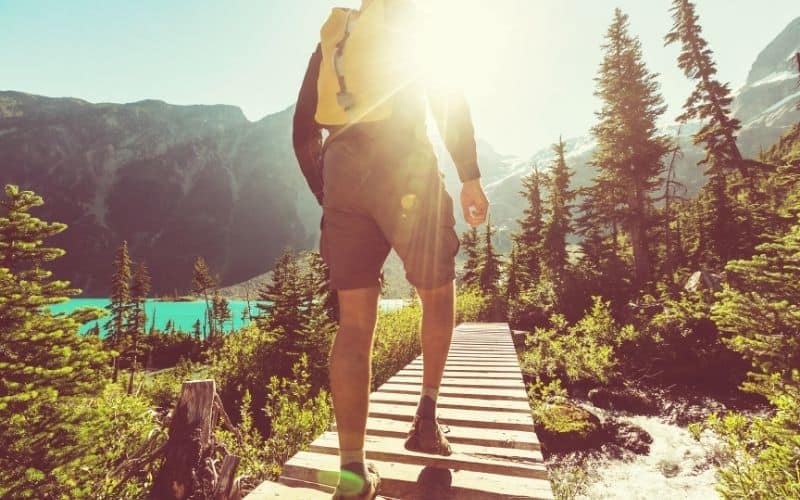
What are tips for creating optimal hiking outfits?
The following list has our top five tips for dressing for the trails.
- Layer Up
- Anticipate Conditions
- Embrace Outfit Fugly
- Treat Your Feet
- Wear Bright Colors
1. Layer Up
The layering system works by wearing multiple layers of thinner, breathable garments instead of relying on one or two bulkier items. This creates air pockets between each layer, enabling interior moisture (sweat) to evaporate outward through the layers. It also offers greater versatility and convenience when the weather changes, since you can take gear on and off with minimal fuss as temperatures fluctuate throughout the day.
This system, described in more detail in our definitive guide to how to layer clothing, is now all but universally accepted as the benchmark for hiking outfits.
2. Anticipate Conditions
Before preparing your pack and getting dressed, the first step in deciding what to wear is to anticipate potential conditions by studying multiple weather forecasts. It’s advisable to factor in a buffer for temperature variations and any potential forecast inaccuracies, especially if your hike is taking you farther afield.
Other factors to take into consideration pre-hike include conditions underfoot, humidity, bugs, trail aspect (in sun or shade), and the duration of your hike. It’s important to plan ahead and pack accordingly, with appropriate footwear, bug repellent, and sun protection. Additionally, if you’re hiking during pregnancy, it’s crucial to consult with your healthcare provider to ensure it’s safe for you and your baby. Consider bringing along a hiking buddy for extra support and assistance, especially during longer hikes.
These variables may require you to take along a few extras. For example (respectively): gaiters or hiking boots instead of shoes, quick-drying garments, facial bug nets, warmer individual layers, and extra items (particularly if on a multi-day excursion).
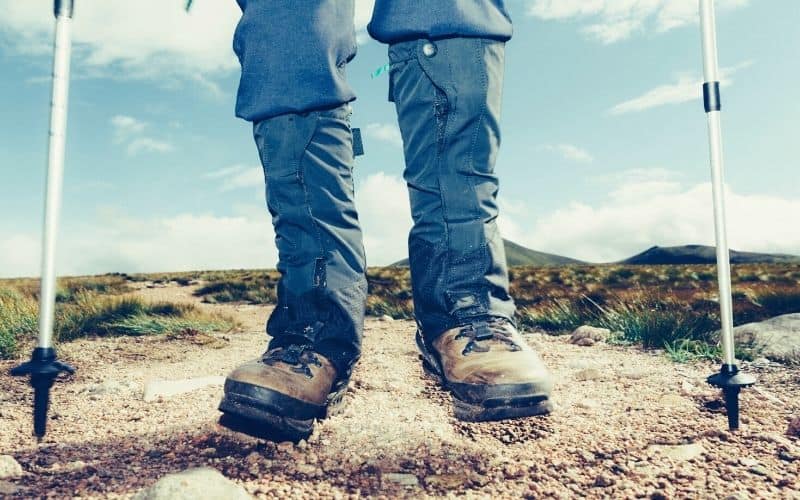
3. Embrace Outfit Fugly
When choosing good hiking clothes many factors take precedence over style, so with that said, you might just have to embrace your outfit fugly. In the wilderness, features like comfort, weight, functionality, durability, performance, and price outweigh style considerations.
4. Treat Your Feet
Whatever your budget, be sure to treat your feet right by choosing boots or shoes that prioritize comfort and are fit for purpose. Ill-fitting or poorly made footwear can cause significant pain, and discomfort, or even lead to injury by causing you to walk with an unnatural gait. Important features to look for include extra ankle support, grippy soles, adequate cushioning, waterproofing, protective toe rand, and/or sufficient arch support.
There are many opinions on whether boots that cover your ankles are a must versus wearing a pair of lightweight hiking shoes or even hiking sandals for summer hiking. In the end, it comes down to the type of terrain you’ll be covering, your walking style, and personal preference.
The main advantage of a hiking shoe is weight savings, with some sources claiming that every pound on our feet equates to having five on your back. It’s worth bearing in mind, however, that if you wear hiking sandals or shoes, you’ll have a lot less protection and support than when wearing boots.
Want to avoid going through a long (and costly) process of trial and error before finding the best hiking shoes or boots for you? If so, be sure to research the options thoroughly, read user reviews, and spend plenty of time trying out your would-be new footwear in the store before heading to the checkout.
While many top-of-the-range, technical hiking or mountaineering boots will set you back enough $ to sponsor a small war, there are plenty of more wallet-friendly options out there for those who have no intention of a cold winter hike scaling the Eiger’s north face or traversing the Himalaya in winter.
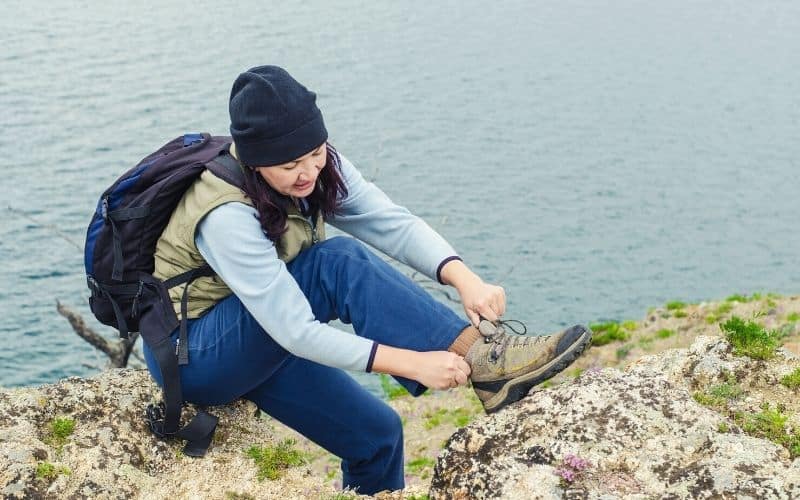
5. Wear Bright Colors
Wearing bright colors is a prudent choice; in case of injury, getting lost, or needing assistance, vibrant clothes will significantly enhance your visibility compared to more muted tones.
Some old-schoolers are apt to lament the visual impact of hikers who look like technicolored candy wrappers out on the trail, but the benefits of wearing slightly garish garb far outweigh the traditionalists’ interests in defending their delicate sensibilities.
Happy With Your Hiking Outfit?
On the trails, your choice of hiking outfit is less about “dress to impress” and more about “dress for hiking success. ” As demonstrated above, this isn’t always straightforward and depends on various variables and personal preferences. However, by following a few basic rules and adapting them to suit the conditions, you’ll have the proper hiking attire for all your hiking adventures. Although there is a rising trend of forgoing clothing completely, and hiking in the nude.
If you liked our article, let us know in the comment box below. And if you’d like to share this post with your friends, share away!
Save for later!!! ⤵️

